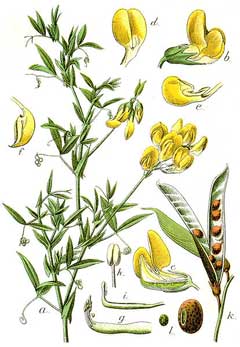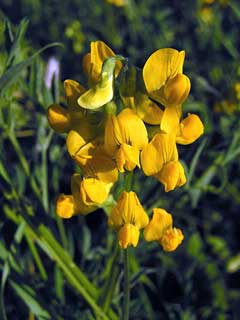 |
|
http://commons.wikimedia.org/wiki/File:Lathyrus_pratensis_Sturm16.jpg |
 |
| http://commons.wikimedia.org/wiki/User:Pethan |
Translate this page:
Summary
Physical Characteristics

 Lathyrus pratensis is a PERENNIAL growing to 1.2 m (4ft).
Lathyrus pratensis is a PERENNIAL growing to 1.2 m (4ft).
See above for USDA hardiness. It is hardy to UK zone 4. It is in flower from May to August, and the seeds ripen from July to September. The species is hermaphrodite (has both male and female organs) and is pollinated by Bees. The plant is self-fertile.
It can fix Nitrogen.
Suitable for: light (sandy), medium (loamy) and heavy (clay) soils. Suitable pH: mildly acid, neutral and basic (mildly alkaline) soils. It cannot grow in the shade. It prefers moist or wet soil.
UK Hardiness Map
US Hardiness Map
Synonyms
Plant Habitats
Meadow; Hedgerow; Bog Garden;
Edible Uses
References More on Edible Uses
Medicinal Uses
Plants For A Future can not take any responsibility for any adverse effects from the use of plants. Always seek advice from a professional before using a plant medicinally.
Resolvent
The seeds are used as a resolvent in Spain[240].
References More on Medicinal Uses
The Bookshop: Edible Plant Books
Our Latest books on Perennial Plants For Food Forests and Permaculture Gardens in paperback or digital formats.

Edible Tropical Plants
Food Forest Plants for Hotter Conditions: 250+ Plants For Tropical Food Forests & Permaculture Gardens.
More

Edible Temperate Plants
Plants for Your Food Forest: 500 Plants for Temperate Food Forests & Permaculture Gardens.
More

More Books
PFAF have eight books available in paperback and digital formats. Browse the shop for more information.
Shop Now
Other Uses
References More on Other Uses
Cultivation details
An easily grown plant, succeeding in any moderately good garden soil but preferring a position in full sun[200]. Succeeds on wet soils. This species has a symbiotic relationship with certain soil bacteria, these bacteria form nodules on the roots and fix atmospheric nitrogen. Some of this nitrogen is utilized by the growing plant but some can also be used by other plants growing nearby[200].
References Carbon Farming Information and Carbon Sequestration Information
Temperature Converter
Type a value in the Celsius field to convert the value to Fahrenheit:
Fahrenheit:
The PFAF Bookshop
Plants For A Future have a number of books available in paperback and digital form. Book titles include Edible Plants, Edible Perennials, Edible Trees,Edible Shrubs, Woodland Gardening, and Temperate Food Forest Plants. Our new book is Food Forest Plants For Hotter Conditions (Tropical and Sub-Tropical).
Shop Now
Plant Propagation
Pre-soak the seed for 24 hours in warm water and then sow in early spring in a cold frame[200]. When they are large enough to handle, prick the seedlings out into individual pots and plant them out in the summer. If you have sufficient seed, then it can also be sown in situ in mid spring[200]. Division in spring. It may not transplant well so care should be taken[200].
Other Names
If available other names are mentioned here
Native Range
TEMPERATE ASIA: Afghanistan, Iran, Iraq (rare), Lebanon, Syria, Turkey, Russian Federation-Ciscaucasia (Ciscaucasia), Armenia, Azerbaijan, Georgia, Russian Federation (Dagestan), Russian Federation-Western Siberia (Western Siberia), Russian Federation-Eastern Siberia (Eastern Siberia), Russian Federation (Altay), Kazakhstan, Kyrgyzstan, Tajikistan, Uzbekistan, Mongolia, Russian Federation (Kurile Islands), China (Gansu Sheng, Guizhou Sheng, Heilongjiang Sheng, Hubei Sheng, Qinghai Sheng, Shaanxi Sheng, Sichuan Sheng, Xinjiang Uygur Zizhiqu, Yunnan Sheng) TROPICAL ASIA: India (Himalayan region), Nepal, Pakistan (north) EUROPE: Denmark, Finland, United Kingdom, Ireland, Norway, Sweden, Czechoslovakia, Austria, Belgium, Switzerland, Germany, Hungary, Poland, Russian Federation (European part), Belarus, Estonia, Lithuania, Latvia, Moldova, Former Yugoslavia, Albania, Bulgaria, Greece, Italy (incl. Sardinia, Sicily), Romania, Spain (incl. Baleares), France (incl. Corsica), Portugal AFRICA: Morocco, Ethiopia (south)
Weed Potential
Right plant wrong place. We are currently updating this section.
Please note that a plant may be invasive in one area but may not in your area so it's worth checking.
Conservation Status
IUCN Red List of Threatened Plants Status :

| Related Plants
|
| Latin Name | Common Name | Habit | Height | Hardiness | Growth | Soil | Shade | Moisture | Edible | Medicinal | Other |
| Lathyrus alatus | | Perennial | 0.6 |
-
| | LMH | SN | M | 1 | 0 | |
| Lathyrus aphaca | Yellow-Flowered Pea | Annual | 0.9 |
-
| | LMH | N | DM | 1 | 1 | |
| Lathyrus cicera | Chickling Vetch, Red pea | Annual | 0.0 |
0-0
| | LMH | N | M | 1 | 0 | |
| Lathyrus davidii | | Perennial | 1.2 |
5-9
| | LMH | SN | M | 1 | 0 | |
| Lathyrus graminifolius | Grassleaf Peavine | Perennial | 0.5 |
4-8
| | LMH | N | DM | 2 | 0 | 2 |
| Lathyrus japonicus | Beach Pea, Smallflower beach pea | Perennial | 0.6 |
3-7
| | LMH | N | DM | 2 | 0 | |
| Lathyrus japonicus maritimus | Beach Pea | Perennial | 0.6 |
3-7
| | LMH | N | DM | 2 | 0 | 3 |
| Lathyrus lanszwertii | Thickleaf, or Aspen Peavine | Perennial | 0.5 |
5-9
| | LMH | N | DM | 2 | 0 | 2 |
| Lathyrus latifolius | Perennial Sweet Pea, Perennial pea | Perennial Climber | 2.0 |
5-9
| F | LMH | SN | DM | 3 | 0 | 2 |
| Lathyrus linifolius montanus | Bitter Vetch | Perennial | 0.6 |
5-9
| | LMH | SN | M | 2 | 0 | 3 |
| Lathyrus nervosus | Lord Anson's Pea | Perennial Climber | 0.5 |
8-11
| | LMH | N | M | 2 | 0 | |
| Lathyrus ochroleucas | Cream Peavine | Perennial | 1.0 |
-
| | LMH | SN | M | 1 | 1 | |
| Lathyrus ochrus | Cyprus Vetch | Annual | 0.6 |
-
| | LMH | N | DM | 1 | 0 | |
| Lathyrus odoratus | Sweet Pea, Wild Pea,Vetchling | Annual Climber | 2.0 |
2-11
| F | LMH | SN | M | 1 | 0 | 3 |
| Lathyrus ornatus | Bush Vetchling | Perennial | 0.3 |
3-7
| | LMH | N | DM | 1 | 1 | |
| Lathyrus palustris | Slenderstem Peavine, Marsh pea | Perennial Climber | 1.2 |
4-8
| | LMH | N | MWe | 1 | 0 | |
| Lathyrus polymorphus | Manystem Peavine, Hoary pea | Perennial | 0.4 |
0-0
| | LMH | N | M | 1 | 0 | |
| Lathyrus quinquenervius | | Perennial | 0.6 |
-
| | LMH | N | MWe | 1 | 0 | |
| Lathyrus sativus | Chickling Pea, White pea | Annual | 0.6 |
0-0
| | LMH | N | M | 2 | 1 | 3 |
| Lathyrus sylvestris | Flat pea, Wood pea | Perennial Climber | 1.5 |
6-9
| F | LMH | SN | M | 0 | 0 | 3 |
| Lathyrus tuberosus | Earthnut Pea, Tuberous sweetpea | Perennial | 1.2 |
5-9
| | LMH | SN | M | 5 | 0 | 3 |
|
Growth: S = slow M = medium F = fast. Soil: L = light (sandy) M = medium H = heavy (clay). pH: A = acid N = neutral B = basic (alkaline). Shade: F = full shade S = semi-shade N = no shade. Moisture: D = dry M = Moist We = wet Wa = water.
Now available:
Food Forest Plants for Mediterranean Conditions
350+ Perennial Plants For Mediterranean and Drier Food Forests and Permaculture Gardens.
[Paperback and eBook]
This is the third in Plants For A Future's series of plant guides for food forests tailored to
specific climate zones. Following volumes on temperate and tropical ecosystems, this book focuses
on species suited to Mediterranean conditions—regions with hot, dry summers and cool, wet winters,
often facing the added challenge of climate change.
Read More
Expert comment
Author
L.
Botanical References
17
Links / References
For a list of references used on this page please go here
Readers comment
| Add a comment |
|
If you have important information about this plant that may help other users please add a comment or link below. Only comments or links that are felt to be directly relevant to a plant will be included. If you think a comment/link or information contained on this page is inaccurate or misleading we would welcome your feedback at [email protected]. If you have questions about a plant please use the Forum on this website as we do not have the resources to answer questions ourselves.
* Please note: the comments by website users are not necessarily those held by PFAF and may give misleading or inaccurate information.
To leave a comment please Register or login here All comments need to be approved so will not appear immediately.
|
Subject : Lathyrus pratensis
|
|
|
|